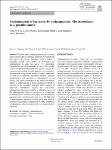Thông tin tài liệu
Thông tin siêu dữ liệu biểu ghi
| Trường DC | Giá trị | Ngôn ngữ |
|---|---|---|
| dc.contributor.author | Li, Cathy W. Y. | - |
| dc.contributor.author | Walters, Stacy | - |
| dc.contributor.author | Müller, Jean-François | - |
| dc.date.accessioned | 2023-08-07T07:01:41Z | - |
| dc.date.available | 2023-08-07T07:01:41Z | - |
| dc.date.issued | 2023 | - |
| dc.identifier.uri | https://link.springer.com/article/10.1007/s13280-023-01858-9 | - |
| dc.identifier.uri | https://dlib.phenikaa-uni.edu.vn/handle/PNK/8720 | - |
| dc.description | CC-BY | vi |
| dc.description.abstract | The detection of anthraquinone in tea leaves has raised concerns due to a potential health risk associated with this species. This led the European Union to impose a maximum residue limit (MRL) of 0.02 mg/kg for anthraquinone in dried tea leaves. As atmospheric contamination has been identified as one of the possible sources of anthraquinone residue, this study investigates the contamination resulting from the deposition of atmospheric anthraquinone using a global chemical transport model that accounts for the emission, atmospheric transport, chemical transformation, and deposition of anthraquinone on the surface. | vi |
| dc.language.iso | en_US | vi |
| dc.publisher | Springer | vi |
| dc.subject | anthraquinone | vi |
| dc.subject | possible source | vi |
| dc.title | Contamination of tea leaves by anthraquinone: The atmosphere as a possible source | vi |
| dc.type | Book | vi |
| Bộ sưu tập | ||
| OER - Khoa học môi trường | ||
Danh sách tệp tin đính kèm:

